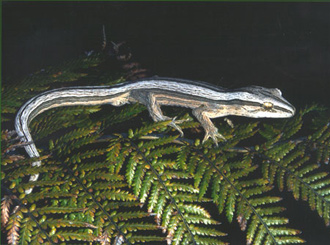|
|
 |
| |
Extremely rare gecko reappears in Coromandel home garden |
| |
17 January 2007
A lone male Coromandel striped gecko Hoplodactylus stephensi 'Coromandel' has appeared in a home garden in the Coromandel township. No other is known to be alive so it is possible the species may effectively be extinct.
It is New Zealand's rarest and most elusive reptile, and the world's rarest gecko.
It is the third live Coromandel striped gecko to be found, since a male was first discouvered in 1997 just 300 metres away.
The Department of Conservation kept the first male safely in captivity, with the expectation of starting a captive breeding program, but he died of old age waiting for a female.
Rob Chappell from DoC who was present when the first Coromandel gecko was discouvered in 1997 said "up until then we didn't even know this thing was on the planet". |
| |
 |
| |
Only two male and one female Coromandel striped gecko have been found alive. Just one male is presently known to be living. |
| |
 |
| |
A female was later found, but unfortunately she died from an attack by a kingfisher. An intensive four-year search in the Port Charles area found only one dead specimen.
The newly found gecko is a male. DoC has started another search, hopefully to find a female. The search is difficult because very little is known about the habits of the Coromandel striped gecko - it has never been seen in its' native habitat.
It is not known if it is nocturnal, or whether it is a ground dweller or prefers trees. Nothing is known about its' breeding habits.
Some geckos are hatched from eggs, and others are born live which is a very unique primitive characteristic of some New Zealand reptiles and frogs.
If the current search is unsuccessful in finding a female partner, Rob Chappell said he will fit the gecko with a transmitter and release him "to take his chances" in a predator-controlled area of bush not far from where he was found. |
| |
 |
| |
 |
|
 |
The Coromandel striped gecko Hoplodactylus stephensi 'Coromandel' is listed in the 2005 New Zealand Threat Classification System as 'nationally critical'.
Image Crown Copyright © Department of Conservation
 View larger image View larger image
Little data is available on many aspects of the biology of striped gecko .....
The species Hoplodactylus stephensi which has been known as the Stephen's Island striped gecko is listed in the 2006 IUCN Red List of Threatened Species as 'vulnerable'. It is only known from Stephen's Island (Takapourewa) in Cook Strait, Maud Island in Peloris Sound, and the Coromandel Peninsula.
The Coromandel striped gecko is distinctly different morphologically, so since its discovery in 1997, the 'Coromandel' and 'Cook Strait' striped geckos have been treated as separate species. However, so far, insufficient Coromandel geckos have been found to establish a description of the separate species.
The Cook Strait striped gecko Hoplodactylus stephensi 'Cook Strait' is listed in the 2005 New Zealand Threat Classification System as 'range restricted', found only on Stephen's Island and Maud Island. Both striped geckos are described as "taxonomically indeterminate" in the threat classification.
The low pregnancy rate of female H. stephensi captured in 1990 and 2002 suggests a low reproductive output for this species of around 0.62 offspring/female/year which is a trait found in other New Zealand geckos (Hare, Cree 2005). This is very low compared with geckos in other overseas locations. |
Longevity of New Zealand gecko .....
A male Cook Strait striped gecko captured on Stephen's Island when it was an adult in 1990, and recaptured in 2002 within a few metres of the first location, was at least 16 years old. The longest recorded lifespan in captivity is ten years, following capture as an adult.
Few geckos have been observed for the decades necessary to determine longevity, however, those that have show long lifespans compared to geckos in other parts of the world. The age of one individual Hoplodactylus duvaucelii on North Brother Island is estimated at 36 years.
Some H. maculatus are estimated to reach a minimum of 27 years of age at Turakirae Head, Wellington (Anastasiadis, Whitaker 1987), and 36 years on Motunau Island, Canterbury (Bannock et al, 1999). The lifespan of the Australian geckos Diplodactylus stenodactylus and D. conspicillatus in the wild is three years. |
|


